In the nights of Teweno, in the past, only animals and insects were heard. Now, the laughs and chatter of those who have gained a few more hours of light thanks to solar energy have joined the community’s soundtrack.
By Susana Roa Chejín
In the nights of Teweno, in the past, only animals and insects were heard. Now, the laughs and chatter of those who have gained a few more hours of light thanks to solar energy have joined the community’s soundtrack.

After more than thirty years of living without electric power, Linda Enqueri had her doubts about the solar panels installed in her native Teweno. After all, the elders of her community, in the southwestern Waorani territory ―in Pastaza, in the middle of the Ecuadorian Amazon― had died waiting for the energy to arrive and listening to promises that never came to fruition. But the light did arrive. It was in December 2021.
Today, over a year after the solar energy systems were installed, Linda Enqueri, mother of four, says that her life and her family’s have changed completely. They used to go to bed as soon as the sun went down because the darkness made it impossible for them to continue with their daily chores. Now the children have more hours to play and do homework, and the adults spend more time with their children and grandchildren.
The solar panels ―made up of two 250-watt plates each, supported by tall gray metal poles― were installed by the Ceibo Alliance Foundation, an organization made up of four of Ecuador’s eleven Amazonian nationalities: Waorani, Siona, Siekopai and A’i Cofán. As of January 2023, they have installed 150 solar panel systems in the communities of these nationalities and plan to install 21 more during the first months of the year.
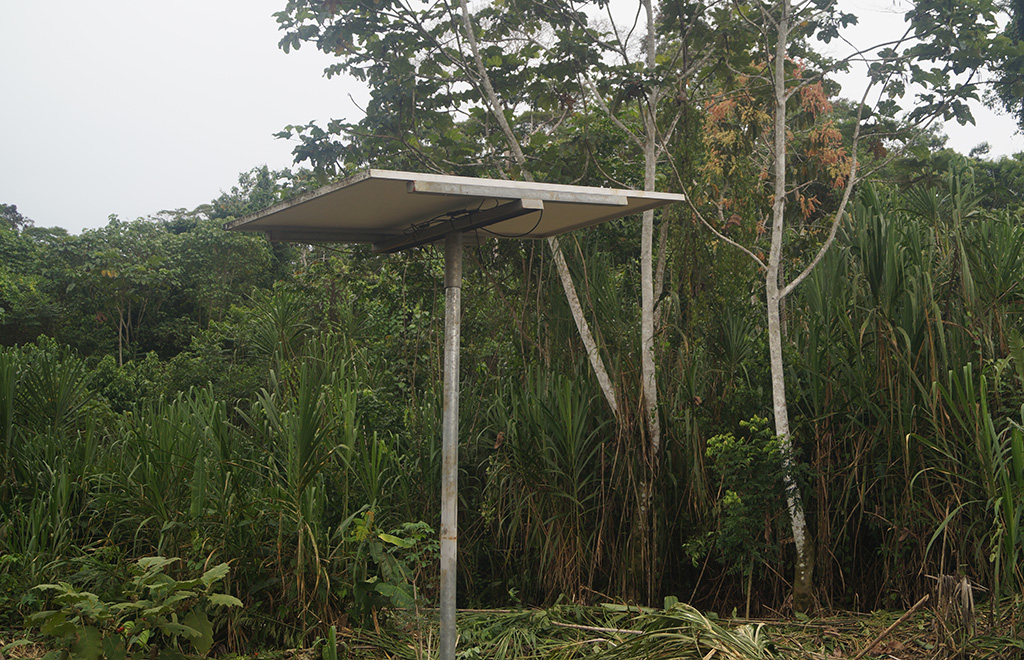
Nine of the systems were installed in guard houses, where the men who patrol the territory live, and from where they monitor possible external threats such as mining, oil extraction, land invaders, and other illegal activities by outsiders.
Before the solar panels, the members of La Guardia de Sinangoe ―the name given to those in charge of protecting the territory of the A’i Cofán nationality― traveled over 60,000 hectares in the Ecuadorian Amazon without being able to charge the batteries of their cameras or their phones. When they ran out of battery power, they could not collect evidence of illegal extractive activities in their territories. Now they can make the treks more relaxed, knowing that they will have access to renewable energy ―which does not harm their territory―to charge their devices.
Between 2001 and 2020, Ecuador had a deforestation rate of approximately 31 thousand hectares on average per year, according to data analyzed by the EcoCiencia Foundation. “It is one of the countries losing its forests at the fastest rate,” María Olga Borja, the foundation’s Mapbiomas technical coordinator for Ecuador, said in an interview in 2022.
In this context, it is critical that Sinangoe’s guard can access electricity to charge their monitoring tools. In addition, although there is no oil exploitation or mining in Teweno, these activities are constant threats in the Pastaza province, where the community lives and which, according to experts, is in a very well-preserved state.
In 2019, the Ecuadorian Government sought to tender a 200,000-hectare oil block No. 22, which overlaps 16% of the territories of the 16 communities of the Waorani nationality in Pastaza. The indigenous people of this nationality publicly objected, arguing that these activities would damage their territory.
After years of protests and legal actions, in September 2022, the Government finally agreed to a temporary moratorium ―for at least one year― on 15 oil blocks in Pastaza and Morona Santiago, including Block No. 22.
Moving away from this oil exploitation to obtain fuels is one of the reasons that drove the communities to look for solutions to generate sustainable energy.
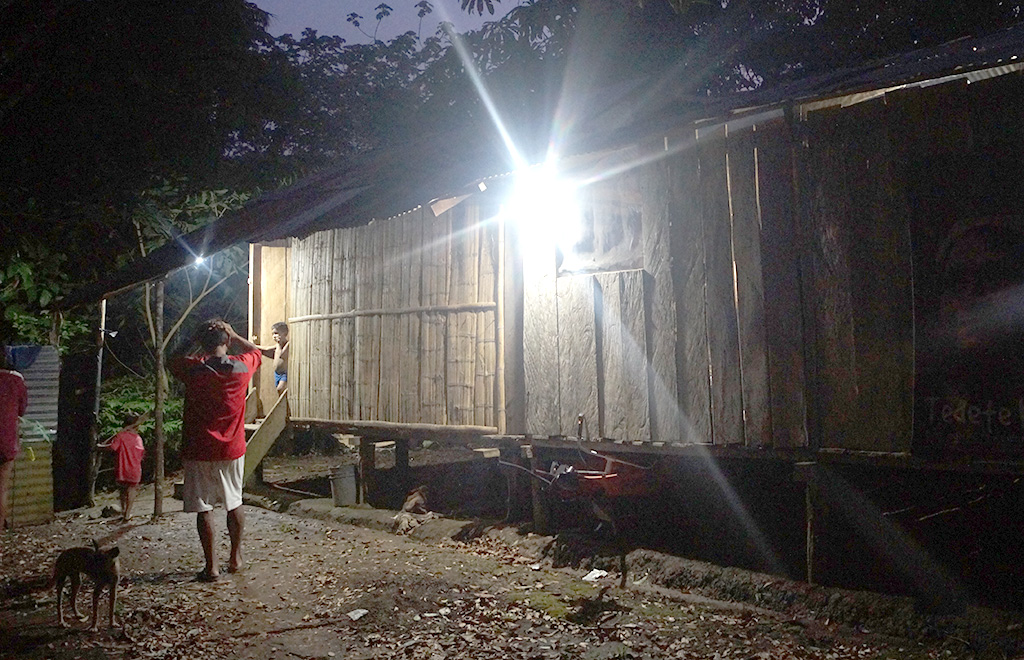
Improved health
Teweno ―which in Wao means “chonta palm”, a tree used to make spears― is home to between 35 and 40 people.
Most of those who come to the community do so in three-, five- or nine-passenger planes that leave from Shell, in Pastaza, and land on a dirt runway in the center of the community, amid hundreds of trees and palms. Around the runway, the houses extend for several kilometers, some on the other side of the Teweno River and others behind mountains.
In Teweno there are 13 families in 15 houses sharing 12 solar panel systems. Some systems feed only one house, and others are shared by two or three houses depending on the area and the needs of the families.
In each system, eight light bulbs can be connected, cell phones can be charged ―although there is no phone signal in the community―, as well as electric tools and even a small television.
Before the arrival of electricity, the inhabitants of Teweno used candles and chimbuzos (canvas bags) to have a few hours of light after the sun went down in the thick darkness of the Amazonian night.
Those who could afford it had a generator that ran on gasoline. However, the villagers recognize that they were polluting, costly, dangerous, and could only be used for a limited time.
Community leader Randy Enqueri says the generators were so noisy that they scared off animals ―making it difficult to hunt and fish, two of the community’s main livelihoods― and made it impossible to hear when someone shouted out an emergency.
They knew it was not a long-term solution, but that it was the only thing available.
As the name implies, solar systems are powered by energy obtained directly from the sun’s light and heat. Specifically, the panels are made of semiconductor materials that absorb light and create a flow of electrons that is converted into electric current.
Linda Enqueri already relies on the solar panels that brought the promised and longed-for electricity. She can’t imagine her days without it. “Now when I go to the other communities that don’t have electricity, it’s hard for me to get used to it,” she says with a laugh. It is 7:30 p.m. at night and he is still cutting the cassava that he deposits in a blackish metal pot on his wood stove. “It used to be impossible to do this at this hour. We would go to sleep at seven o’clock at night, like chickens.”

The solar panels gave the people of Teweno that time they didn’t have before because everything was dark.
Juan Enqueri came to Teweno eight years ago to work as a teacher in the community’s only school. There he met his wife Wentoca Yeti and now they live in a blue wooden house near the airstrip with their two sons, Ovo and Oto, aged three and five.
Juan Enqueri also had a generator in his house and says that, in addition to the cost of gasoline, it affected his health. Loading the fuel that he brought from Puyo ―the cantonal head of the capital of the province of Pastaza― was dangerous, he says, because sometimes it spilled and burned the skin of the person who was carrying that gallon on its shoulders.
Randy Enqueri, the president of the community, remembers that when they had the generators, the inhabitants suffered from headaches, flu and fever. Those problems, which could be related to the toxic emissions from the generators, diminished when the panels arrived. We are fine now, we have light, no noise, no danger, we are calm,” he says and sighs with relief.
Betting on solar energy
Alianza Ceibo started the solar energy project in 2016 with investment from a German organization called Love for Life. Now they are supporting it with funds from the Honnold Foundation, which gives grants to organizations that promote access to solar energy around the world.
The process to install solar panels is long. Jairo Irumenga, representative of the Waorani nationality in Alianza Ceibo, explains that, because resources are limited, they must first analyze which communities will be prioritized. In many cases, it is difficult to enter the communities because of the size and weight of the parts of the system, especially the panels and the poles that support them.
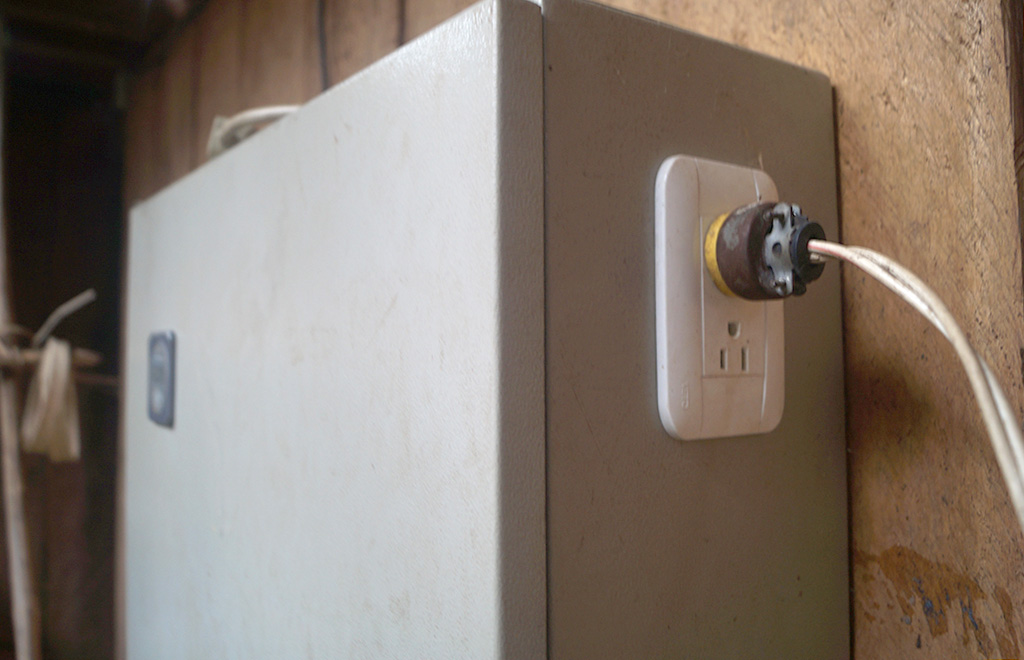
That was one of the difficulties they faced at Teweno. Irumenga says they first tried to carry the panels and poles in the larger nine-passenger planes, but they did not fit in the plane’s cabin and could only transport the batteries. In the end, they were transported by canoe down the Curaray River to the Yoweweno mouth and then to the community. From there, each family was responsible for transporting their system to their home. The hike can take 40 minutes, but because of the weight on their shoulders, it took them almost three hours.
If cared for, the panels can last up to 20 years and the batteries, ten. To make this happen, there are those who receive training within the community. They are in charge of giving basic maintenance to each system. If there is a problem that involves changing parts or deep repairs, they call engineer Luis Muñoz, who takes 24 hours to get to the community between car and plane rides.
After installation, during the first year, the technician in charge of the community makes periodic maintenance visits. After that, it is the responsibility of each family to check that everything is working and if they find any problem, they must call the technician. Randy Enqueri says that so far, in this first year, they have not had any inconvenience.
More light, more resources
Before solar electricity came to Teweno, every three or four months, Linda Enqueri spent USD30 to buy fuel for her electric generator. She would purchase five gallons, which cost between five and six dollars each. “By saving, not turning it on every day, just for a couple of hours on certain nights, it lasted us four months at the most,” she explains. Since it was too expensive for the time they could use it, Enqueri preferred to buy candles. That was also complicated. He had to walk four or five hours to go to the city to buy the candles, which could only be lit for a couple of hours each night. The packages cost between two and three dollars, but they lasted a week at most.
The solar panels, on the other hand, cost Linda Enqueri and her community nothing, and give them light all night long. The systems are designed to provide power for up to three days at a time, assuming they cannot be charged because there is no sun at all. According to engineer Luis Muñoz, “If there are cloudy days or rainy days the system still has charging capacity. It is not the same as receiving full solar radiation, but it is like its minimum limit,” he says.
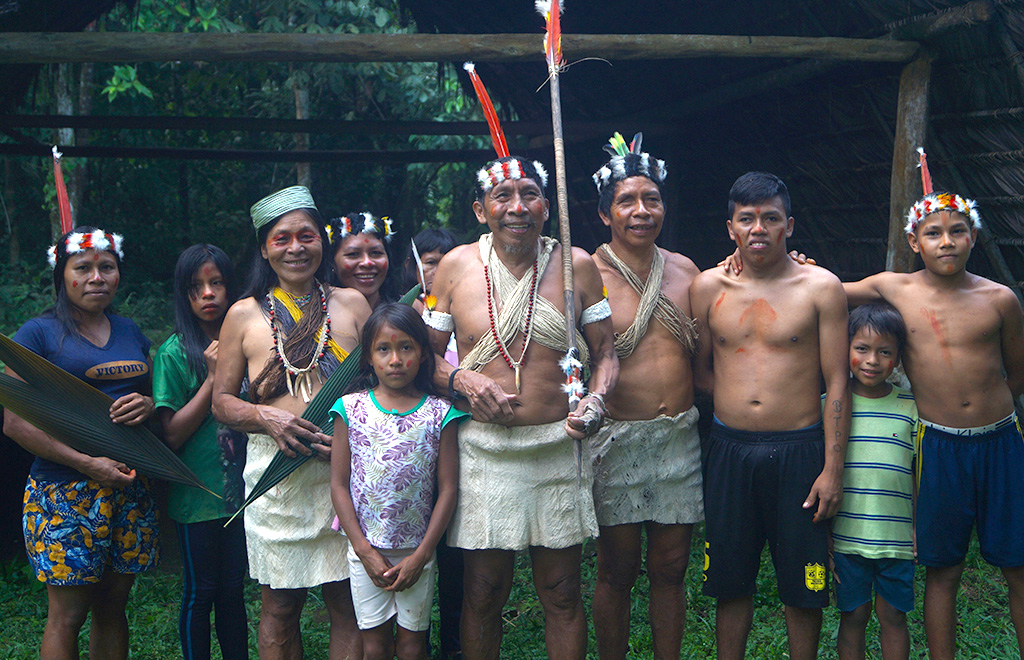
Long gone are the nights when they had to turn off candles or generators to save money. Konta, a brown-skinned woman who always wears several necklaces wrapped around her neck and who thinks she is 50 years old, says ―in Wao, while Jairo Irumenga translates― that when she travels outside the community she asks her neighbors to turn on the light outside her house to “scare away the tigers,” as they call the jaguars. She does this to protect her animals, including her pet: a small, colorful toucan that hops between the wooden walls of her house.
In addition to the money they save, because they no longer buy fuel, renewable energy has allowed the people of Teweno to invest more time in another source of income: making handicrafts.
After cooking, eating and washing dishes, after nine o’clock in the evening, with her long black hair tied back in a twist that looks like it will soon come loose, Linda Enqueri sits on the wooden floor of her living room with a red plastic basket in which she keeps the seeds, rope, scissors and other tools for making handicrafts. Like many of the families in the community, she makes earrings, bracelets, bags, spears and blowguns.
The handicrafts are sold to tourists who come to Teweno to visit a waterfall 40 minutes from the community. Sometimes they are also sold at the Association of Waorani Women of the Ecuadorian Amazon (Amwae). After they installed the solar panel next to their house, Juan Enqueri bought a power tool to drill the seeds with which he and his wife Wentoca Yeti make the handicrafts. That, he says, allows them to make them much faster than with a hand tool.
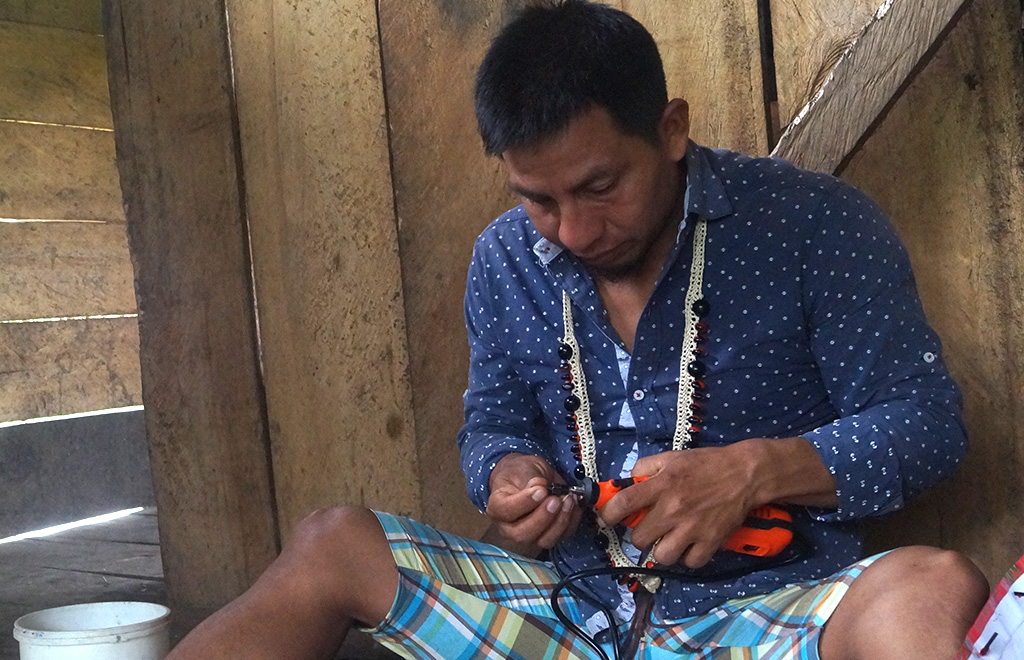
More time with the family
Linda, Randy and Juan Enqueri say that in the past, only crickets, toads and birds could be heard in the evenings in Teweno. Now they also hear laughter and the voices of those who talk in their homes. Dabeta Tañi―- 47 years old, with slightly curly hair and an infectious laugh ―-says that one of the biggest benefits is that they can spend more time as a family. Before, they couldn’t stay up talking after eating, because if it was already late they had to blow out the candle and go to bed. Now, he says with a smile, “there’s no limit”.
Solar panels have made it easier to raise children. Omamo, 68, says she cared for her seven children in near darkness. As she cooks a pot full of saino that her husband hunted the night before ―-an animal also known as collared peccary (Dicotyles tajacu)―- she says that when her babies cried at night she would light a candle to check their diaper or feed them, but would put it out right away so it wouldn’t burn out.
Oma Yeti, one of the grandparents in the Teweno community, says that having light at night has allowed him to talk more with his grandchildren. As he sits in a hammock, surrounded by five white dogs of different sizes that sleep and play, he says he tells the younger ones about the history of his nationality, explains how to make a blowgun, and how the confrontations with other communities were.
The solar panels have also made Teweno safer. Randy Enqueri says that without the noise of the generators, a call for help can now be heard in case of an emergency. Also, with light, accidents like the one his father Ñihua Enqueri had nine years ago are less likely to happen. One night, when he returned from hunting, he was cutting the meat of the animal he had killed when he cut the tip of his left index finger. Now that there is light, Ñihua Enqueri says in wao, while proudly showing one of the spears he uses to hunt, “there is no longer any risk of cutting his fingers.”
Linda Enqueri wants her children to continue studying. Her dream, she says, is that they “can improve more than me”, so that they can live in better conditions. For this dream to come true, Linda hopes that in the future she will be able to have internet at home.
It is not an isolated wish. That is also the plan Randy Enqueri has for Teweno. They also want to put a solar panel in the area where the school and the health center are located, which, for now, is not working. Using that, they could illuminate the place where the airstrip is and the common areas of the community.
Randy Enqueri hopes these actions will reduce the risks in emergencies, because in addition to illuminating an area that currently has no light, having internet would connect Teweno with the city. “We have no way to call in case of an emergency, if someone breaks a bone or is bitten by a snake, we have to walk 30 minutes to get a signal.” With another solar panel and an internet connection, that and other lingering problems would be solved.
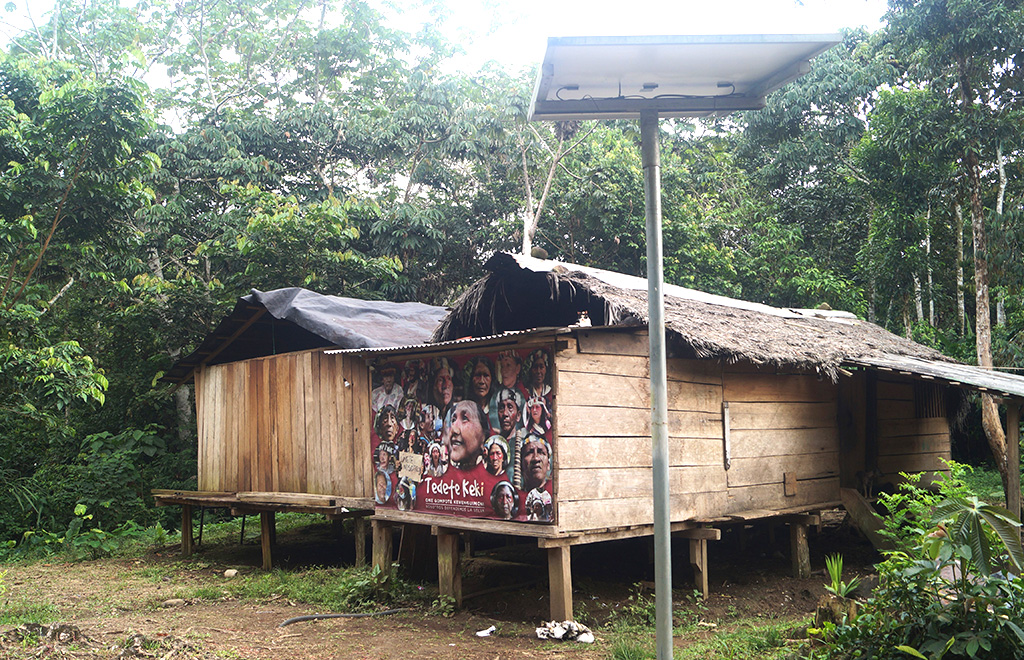
In the coming months, Alianza Ceibo plans to bring 21 solar energy systems to different communities, so they can be installed in territorial guard houses, schools, family homes and the homes of indigenous women’s associations.
Jairo Irumenga says there will always be more communities that need help from these and other projects. “Many ask us why they do and we don’t,” he says. That is why they have been seeking more funding from new organizations to reach even more remote communities that, like Teweno, would benefit from solar energy.
Hernán Payaguaje, of the Siekopai nationality, founder and board member of the Ceibo Alliance Foundation, says that they have “the hopes of thinking of a different Amazon, in territories that are still alive for us and for future generations”.
Susana Roa Chejín (Ecuador, 1997) Journalist from Loján and editor-in-chief of GK. She covers economics, sexuality and rights. She is interested in employment, financial education and sexual and reproductive health.
This report is a collaboration between Mongabay Latam and GK
This story was originally published in GK (Ecuador) and is republished as part of the Human Journalism Network Programme, supported by the ICFJ, International Center for Journalists.
